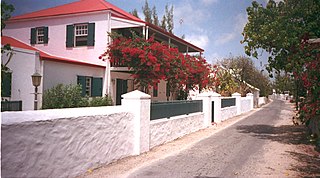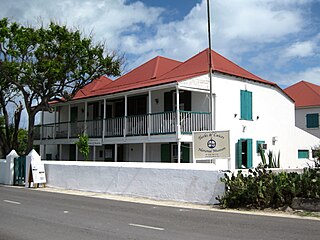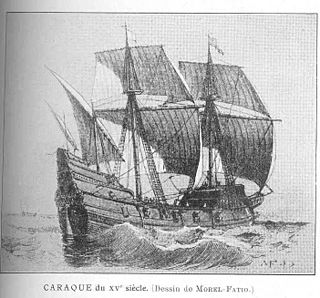Related Research Articles
Wrecking is the practice of taking valuables from a shipwreck which has foundered or run aground close to shore. Often an unregulated activity of opportunity in coastal communities, wrecking has been subjected to increasing regulation and evolved into what is now known as marine salvage.
The Lucayan people were the original residents of The Bahamas before the European conquest of the Americas. They were a branch of the Taínos who inhabited most of the Caribbean islands at the time. The Lucayans were the first indigenous Americans encountered by Christopher Columbus. Shortly after contact, the Spanish kidnapped and enslaved Lucayans, with the displacement culminating in complete eradication of Lucayan people from the Bahamas by 1520.

A shipwreck is the wreckage of a ship that is located either beached on land or sunken to the bottom of a body of water. Shipwrecking may be intentional or unintentional. There were approximately three million shipwrecks worldwide as of January 1999, according to Angela Croome, a science writer and author who specialized in the history of underwater archaeology.

Cockburn Town is the capital of the Turks and Caicos Islands, spreading across most of Grand Turk Island. It was founded in 1681 by salt collectors.

Rum Cay is an island and district of the Bahamas. It measures 30 square miles (78 km2) in area, it is located at Lat.: N23 42' 30" - Long.: W 74 50' 00". It has many rolling hills that rise to about 120 feet.
San Pedro Underwater Archaeological Preserve State Park is a Florida State Park located in 18 feet (5.5 m) of water, approximately 1.25 nautical miles (2.32 km) south of Indian Key. It became the second Florida Underwater Archaeological Preserve when it opened to the public in 1989. The heart of the park is the San Pedro, a submerged shipwreck from a 1733 Spanish flotilla, around which visitors can dive and snorkel. The San Pedro, a 287-ton Dutch-built vessel, and 21 other Spanish ships under the command of Rodrigo de Torres left Havana, Cuba, on Friday, July 13, 1733, bound for Spain. The San Pedro carried a cargo of 16,000 silver Mexican pesos and crates of Chinese porcelain. A hurricane struck the fleet, while entering the Straits of Florida, and sank or swamped most of the fleet. The wrecksite includes an "eighteenth century anchor, replica cannons, ballast stones encrusted with coral, a dedication plaque, and a mooring buoy system." The wreck was added to the U.S. National Register of Historic Places on May 31, 2001.

Bilboes are iron restraints normally placed on a person's ankles. They have commonly been used as leg shackles to restrain prisoners for different purposes until the modern ages. Bilboes were also used on slave ships, such as the Henrietta Marie. According to legend, the device was invented in Bilbao and was imported into England by the ships of the Spanish Armada for use on prospective English prisoners. However, the Oxford English Dictionary notes that the term was used in English well before then.

Treasure hunting is the physical search for treasure. For example, treasure hunters try to find sunken shipwrecks and retrieve artifacts with market value. This industry is generally fueled by the market for antiquities. The practice of treasure-hunting can be controversial, as locations such as sunken wrecks or cultural sites may be protected by national or international law concerned with property ownership, marine salvage, sovereign or state vessels, commercial diving regulations, protection of cultural heritage and trade controls.

Middle Caicos is the largest island in the Turks and Caicos Islands. To the west, it is separated from North Caicos by Juniper Hole, and to the east, from East Caicos by Lorimer Creek, both narrow passages that can accommodate only small boats. The island is known for its extensive system of caves and its significant Lucayan Indian archaeological sites. The island is connected to North Caicos via a causeway. Middle Caicos was previously called Grand Caicos, although this name is not used today.

East Caicos is the fourth largest island in the Turks and Caicos Islands. To the west, it is separated from Middle Caicos by Lorimer Creek, a narrow passage that can accommodate only small boats. To the south is South Caicos. East Caicos has no inhabitants.
The Henrietta Marie was a slave ship that carried captive Africans to the West Indies, where they were sold as slaves. The ship wrecked at the southern tip of Florida on its way home to England, and is one of only a few wrecks of slave ships that have been identified.
Odyssey Marine Exploration, Inc. is an American company engaged in deep-ocean exploration with a focus on the exploration, development and validation of subsea mineral resources. Starting out as a shipwreck pioneer, Odyssey has discovered some of the most famous deep-ocean shipwrecks in history including the SS Republic, Nuestra Señora de las Mercedes, HMS Victory, SS Gairsoppa and SS Ancona. Their work has been featured on the Discovery Channel, PBS and National Geographic.
Trouvadore was a Spanish slave ship that was shipwrecked in 1841 near East Caicos in the course of a run transporting Africans to be illegally sold to the sugarcane plantations in Cuba. As the United Kingdom had a treaty with Spain prohibiting the international slave trade and had abolished slavery in its colonies in 1833, it freed the 192 slaves who survived the wreck. Individuals and families, a total of 168 Africans, were placed with salt proprietors for apprenticeships in the Turks and Caicos Islands; the remaining 24 Africans were settled in Nassau.

SS Comet was a steamship that operated on the Great Lakes. Comet was built in 1857 as a wooden-hulled propeller-driven cargo vessel that was soon adapted to carry passengers. It suffered a series of maritime accidents prior to its final sinking in 1875 causing the loss of ten lives. It became known as the only treasure ship of Lake Superior because she carried 70 tons of Montana silver ore when it sank. The first attempts to salvage its cargo in 1876 and 1938 were unsuccessful. Comet was finally salvaged in the 1980s when the Great Lakes Shipwreck Historical Society illegally removed artifacts from the wreck. The artifacts are now the property of the State of Michigan and are on display as a loan to the Great Lakes Shipwreck Museum. The fate of her silver ore cargo is unknown. Comet's wreck is now protected by the Whitefish Point Underwater Preserve as part of an underwater museum.


Yassi Ada is an island off the coast of Bodrum, Turkey. This area of the Mediterranean Sea is prone to strong winds, making a safe journey around the island difficult. The island could be called a ships' graveyard, on account of the number of wrecked ships off its southeastern tip. Three wreck sites have been excavated under the direction of George Bass of Texas A&M University. The first to be studied using archaeological techniques was a 4th-century Byzantine wreck, the second a 7th-century Byzantine wreck, and the third a 16th-century Ottoman wreck. Bass received funding for a summer excavation at the site from the University Museum of the University of Pennsylvania and the National Geographic Society.

The Turks and Caicos National Museum is the national museum of the Turks and Caicos Islands. It is located in Guinep House on Front Street to the north of Cockburn Town on Grand Turk Island, which is also the capital of the archipelago. Established in the 1980s and opened in 1991, the museum is publicly funded as a nonprofit trust. It exhibits pre-historic Lucayan culture and records the history of the islands of the colonial era and the slave trade, all related to the sea. An arboretum is adjacent to the museum.

San Esteban was a Spanish cargo ship that was wrecked in a storm in the Gulf of Mexico on what is now the Padre Island National Seashore in southern Texas on 29 April 1554.
Margaret E. "Peggy" Leshikar-Denton is an archaeologist specialising in underwater archaeology, and director of the Cayman Islands National Museum.
References
- Keegan, Donald H. (1990). The People Who Discovered Columbus. Gainesville, Florida: University Press of Florida. ISBN 0-8130-1137-X.
- Keith, Donald H. (2006). "The Molasses Reef Wreck" (PDF). In Nutley, David; Cochran, Ian (eds.). Underwater cultural heritage at risk: Managing natural and human impacts (PDF). Paris: International Council on Monuments and Sites.
- Leshikar-Denton, Margaret E. (2002). "Problems and Progress in the Caribbean" . In Ruppe, Carol V; Barstad, Janet (eds.). International handbook of underwater archaeology. pp. 279–298. doi:10.1007/978-1-4615-0535-8_18. ISBN 0-306-46345-8.
- "A Brief History of the Molasses Reef Wreck". Turks and Caicos National Museum. 2018. Retrieved 19 December 2020.
- "Molasses Reef Shipwreck Part 1. What Type of Ship was the Molasses Reef Wreck?". Turks and Caicos National Museum. 2018. Retrieved 19 December 2020.
- "Molasses Reef Shipwreck Part 2. The Weapons". Turks and Caicos National Museum. 2018. Retrieved 19 December 2020.
- "Molasses Reef Shipwreck Part 3. The Pottery". Turks and Caicos National Museum. 2018. Retrieved 19 December 2020.
- "Molasses Reef Shipwreck Part 4. Why was the ship here?". Turks and Caicos National Museum. 2018. Retrieved 19 December 2020.